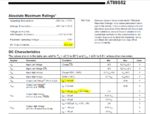welove8051
Full Member level 6
hi, can any one clarify about the following things WRT to I/O pins on 89s52 micro controller. kindly refer attached image.
1, What is the meaning of IOL = 1.6mA, with respect to VOL(0.45 V max)? is it minimum sink current when no output is connected?
2, similarly for VOH, IOH = -60uA? how is it related with VOH minimum of 2.4V? is it minimum source current when no output is connected?
3, How are the above values VOL & IOL and VOH & IOH related, If i am not wrong can we use this to determine output pin resistance?


General questions:
5, what happens when more current is sourced from or sinked into the I/O pin?
6, what happens when a high level output pin is shorted to low level output pin of same controller?
7, what happens when different controller(atmega8 and 89s52 ) are interfaced as output, like ATM8 as logic high O/P and S52 has logic low O/P?
thanks in advance
regards
kj
1, What is the meaning of IOL = 1.6mA, with respect to VOL(0.45 V max)? is it minimum sink current when no output is connected?
2, similarly for VOH, IOH = -60uA? how is it related with VOH minimum of 2.4V? is it minimum source current when no output is connected?
3, How are the above values VOL & IOL and VOH & IOH related, If i am not wrong can we use this to determine output pin resistance?

General questions:
5, what happens when more current is sourced from or sinked into the I/O pin?
6, what happens when a high level output pin is shorted to low level output pin of same controller?
7, what happens when different controller(atmega8 and 89s52 ) are interfaced as output, like ATM8 as logic high O/P and S52 has logic low O/P?
thanks in advance
regards
kj